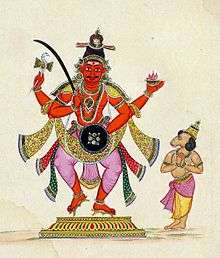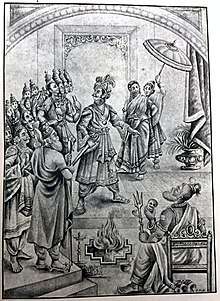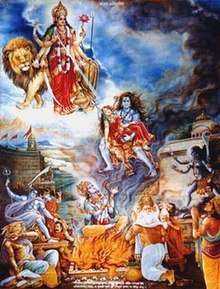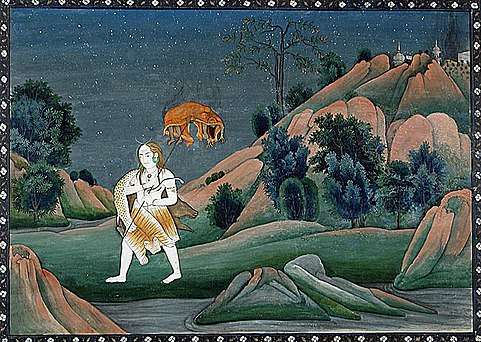Daksha
According to Sanatana Dharma (Hindu Religion), Dakṣa (Sanskrit: दक्ष, lit. "able, dexterous, or honest one"[1]) is one of the sons of Lord Brahma, who, after creating the ten Manas Putras, created Daksha, Dharma, Kamadeva and Agni from his right thumb, chest, heart, and eyebrows, respectively.[2] Artwork shows him as an obese man with a stocky body, protruding belly, and the head of an ibex-like creature with spiral horns.
| Daksha | |
|---|---|
God of kings | |
 Ram-faced Daksha prajapati (right) with Virabhadra | |
| Devanagari | दक्ष |
| Personal information | |
| Parents | Brahma Saraswati |
| Siblings | Four Kumaras and Narada |
| Consort | Prasuti Panchajani |
| Children | Aditi, Diti, Sati, Svaha, Kadru, Vinata, Rohini, Revati, Rati, Khyati and many others |
Daughters
- See also: Daughters of Daksha

According to Vishnu Purana and Padma Purana, Daksha and his wife Prasuti had 24 daughters. The names of these 24 daughters are:
- Sraddha (Faith)
- Bhakti (Worship)
- Dhriti (Steadiness)
- Thushti (Resignation)
- Pushti (Thriving)
- Medha (Intelligence)
- Kriya (Action, Devotion)
- Buddhika (Intellect)
- Lajja Gauri (Modesty)
- Vapu (Body)
- Santi (Expiation)
- Siddhika (Perfection)
- Kirtti (Fame)
- Khyati (Celebrity)
- Sati (Truth)
- Sambhuti (Fitness)
- Smriti (Memory)
- Priti (Affection)
- Kshama (Forgiveness)
- Sannati (Humility)
- Anasuya (lit. without jealousy)
- Urjja (Energy)
- Swaha (Offering)
- Swadha (Oblation)[3]
Of these, the 13 married to Dharma are:
- Sraddha
- Bhakti
- Dhriti
- Thushti
- Pushti
- Medha
- Kriya
- Buddhi
- Lajja
- Vapu
- Santi
- Siddhi
- Kirtti
Of the remaining 11,
- Khyati is married to Bhrigu
- Sati is married to Shiva
- Sambhuti is married to Marichi
- Smriti is married to Angiras
- Priti is married to Pulastya
- Kshama is married to Pulaha
- Sannati is married to Kratu
- Anasuya is married to Atri
- Urjja is married to Vasishtha
- Swaha is married to Agni
- Swadha is married to Pitris[4]
According to Matsya Purana, Daksha and his wife Panchajani (Virani) had 62 daughters, not one of whom resembled their father:
- 10 of those daughters were married to Dharma,
- 13 to sage Kashyapa,
- 27 to Chandra,
- 4 to Arishtanemi,
- 1 to Kama,
- 1 to lord Shiva,
- 2 to sons of sage Bhrigu,
- 2 to sage Angiras,
- 2 to Krisasva.[5][6]
According to Padma Purana, when Daksha felt the number of women are still not sufficient, he decided to have 60 more daughters. Sati was the daughter married to Shiva.[7]
The 10 daughters married to Dharma are:
The 13 daughters married to sage Kashyapa are:
- Aditi,
- Diti,
- Danu
- Arishta,
- Surasa,
- Surabhi,
- Vinata,
- Tamra,
- Krodhavasha,
- Ira,
- Kadru,
- Vishva,
- Muni.[9][10]
The 27 daughters married to Chandra are:
- Ashvinī, (Aswathy)
- Bharanī,
- Kṛttikā (the Pleiades), (Karthika)
- Rohinī,
- Mrigashīra, (Makayiram)
- Ārdrā, (Thiruvathira)
- Punarvasu, (Punartham)
- Pushya, (Pooyam)
- Ashlesha, (Ayilyam)
- Maghā, (Makam)
- Pūrvaphalgunī, (Pooram)
- Uttaraphalgunī, (Uthram)
- Hasta, (Atham)
- Chitrā (Spica), (Chithira)
- Svātī (Arcturus), (Chothi)
- Vishākhā, (Visakham)
- Anurādhā or Rādha, (Anizham)
- Jyeshtha, (Thrikketta)
- Mūla, (Moolam)
- Purbashādha or Pūrvashādhā, (Pooradam)
- Uttarashara, (Uthradam)
- Shravana, Abhijit, (Thiruvonam)
- Dhanistha, (Avittam)
- Shatabhisha, (Chathayam)
- Pūrva Bhādrapadā, (Pooruruttathi)
- Uttarbhadrapada, (Uthruttathi)
- Revatī (Revathi)
Daksha's Curse
After loosing Tara, Chandra's lust for union grew. To satisfy his lust, he married twenty-seven daughter of Daksha, who are the twenty-seven Nakshatras or Constellations on the Moon's orbit.
Of his 27 wives, Chandra fell in love with his chief wife, Rohini. He spent most of his time with her. This enraged the other wives of Chandra and they complaint this to their father. Daksha realised Chandra's intentions and cursed him to lose his glory. Chandra felt guilty of his act and asked for forgiveness. Shiva, later partially restored Chandra's glory.[11]
Story of Sati and Shiva
One of the daughters of Daksha (often said to be the youngest) was Sati (Dakshayani), who had always wished to marry Shiva. Daksha forbade it, but later reluctantly allowed her and she married Shiva. She found in Shiva a doting and loving husband.
Daksha Yagna


Daksha Yagna was an important turning point in the creation and development of sects in Hinduism. It is the story behind the 'Stala Purana' (Origin story of Temples) of Shakti Peethas. There are 51 (some say 108) Shakti Peethas shrines all over South Asia. The story replaced Goddess Sati by Shree Parvati as Shiva's consort and lead to the story of Lord Ganesha and Lord Kartikeya.

Once, Daksha organised the Brihaspatistava Yajna and intentionally avoided Shiva and Sati. Even though discouraged by Shiva, who told her not to go to a ceremony performed by Daksha where she and her husband were not invited; the parental bond made Sati ignore social etiquette and her husband's wishes. Sati went to the ceremony alone. She was snubbed by Daksha and insulted by him in front of the guests. Sati, unable to bear further insult, ran into the Sacrificial fire and immolated herself. Some other legends say that she invoked Yogic flames & immersing herself in it, burnt to death. Shiva, upon learning about the terrible incident, in his wrath invoked Virabhadra and Bhadrakali by plucking a lock of hair and thrashing it on the ground. Virabhadra and the Bhoota ganas marched south and destroyed all the premises. Daksha was decapitated, and the Yagna shaala was devastated during the rampage. Bhrigu, the chief priest of the Yajna, invoked the Ribhus to fight the Ganas, but the former was tied to a pillar & his beard was forcibly plucked off. According to Horace Hayman Wilson, "Vahni's hands were cut, Bhaga's eyes were plucked out, Pusha had broken teeth, Yama's mace was broken, Goddesses' noses were cut, Soma was pummelled, while Yajneshwara, the Indra of Swayambhuva Manvantara, tried to escape in the form of a deer, but was decapitated. Daksha also tried to escape, but Virabhadra held him & cut off his head (some legends say that he plucked off Daksha's head with his own hands). The head was thrown to the fire, & Virabhadra returned to Kailasa, along with his hordes.
Later, Shiva's anger cooled down, & he forgave Daksha & brought him back to life, but with a goat's head. Bhrigu & the others were restored their respective parts, which they lost. With Vishnu as the chief priest, Daksha offered a share of the obalations to Shiva, & the sacrifice was successfully completed.
Vishnu attempted to pacify Shiva, who was in deep grief upon seeing the half-burned corpse of his beloved wife. However, Shiva, unable to part with Sati, carried her corpse on his shoulder and wandered about the world. Vishnu restored calm and rid of Shiva's attachment by severing Sati's body into multiple pieces with his divine discus, the Sudarshan Chakra. Sati's severed body parts fell in various places where Shiva had traveled. The places where Sati Devi's body parts fell came to be known as Shakti Peethas.
Much later, in the Vaiwaswatha Manvantara, Daksha is reborn as the son of the Prachetas & Marisha (in Dhruva's lineage). He married Panchajani, also known as Asikni, & had 60 daughters, 5000 sons named Haryashwas, & 1000 sons named Shabalashwas. The details of the 60 daughters are given above. [12][13]
See also
References
- Monier-Williams Sanskrit-English Dictionary
- The Matsya Puranam P-I (B.D. Basu) English Translation Ch #3, Page 10
- Vishnu Purana, Vol-I, H.H. Willson. Book-I,Ch-#7, Page 109
- Vishnu Purana, Vol-I, H.H. Willson. Book-I,Ch-#7, Page 109-11
- The Matsya Puranam P-I (B.D. Basu) English Translation Ch #5, Page 17
- Matsya Purana (Sanskrit) Ch #5, Sloka 10-12
- Wilkins, W.J. (2003). Hindu Mythology. New Delhi: D.K. Printworld (P) Limited. p. 373. ISBN 81-246-0234-4.
- Matsya Purana (Sanskrit) Ch #5, Sloka 15-16
- The Matsya Puranam P-I (B.D. Basu) English Translation Ch #5, Page 18
- Matsya Purana (Sanskrit) Ch #6, Sloka 1-2
- Roshen Dalal (2010). Hinduism: An Alphabetical Guide. Penguin Books India. pp. 393–394. ISBN 978-0-14-341421-6.
- the Horse-sacrifice of the Prajapati Daksha The Mahabharata translated by Kisari Mohan Ganguli (1883–1896), Book 12: Santi Parva: Mokshadharma Parva: Section CCLXXXIV. p. 317. “I am known by the name of Virabhadra’’ and I have sprung from the wrath of Rudra. This lady (who is my companion), and who is called Bhadrakali, hath sprung from the wrath of the goddess.”
- http://www.hindu.com/2006/06/17/stories/2006061708850500.htm
- Dictionary of Hindu Lore and Legend (ISBN 0-500-51088-1) by Anna Dhallapiccola
External links
| Wikimedia Commons has media related to Category:Daksha. |
